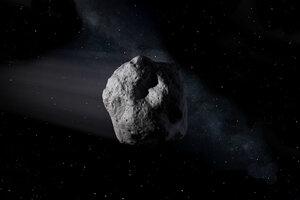If an asteroid were hurtling toward L.A., what would NASA do?
In a recent exercise, US government agencies worked together to develop an effective contingency plan for incoming asteroids.

NASA and FEMA convened last month to develop hypothetical emergency plans for Earth-bound space objects, like the asteroid depicted in this illustration.
NASA/JPL-Caltech
Last month, five government agencies convened in El Segundo, Calif., to discuss a looming threat. In 2020, their directive stated, a massive asteroid could strike a densely-populated location in the southern half of the state. The agents in attendance, lit by harsh fluorescent lights, were going to have to come up with a plan.
But this threat was entirely hypothetical – at least for now. The meeting was actually a “tabletop exercise,” in which NASA and the Federal Emergency Management Agency (FEMA) worked together to respond to simulated impact scenarios. The goal was to develop an effective contingency plan – one that minimizes loss and prevents panic – in case a meteor ever does come careening towards a major city.
"It's not a matter of if, but when, we will deal with such a situation," Thomas Zurbuchen, NASA's Science Mission Directorate's new associate administrator, said in a statement. "But unlike any other time in our history, we now have the ability to respond to an impact threat through continued observations, predictions, response planning and mitigation."
History offers some clues about such an event.
On the morning of June 30, 1908, a large meteor exploded in mid-air near Russia’s Stony Tunguska River. No casualties were reported, as the area was sparsely populated, but the so-called Tunguska event flattened nearly 800 square miles of forest. New York City, by comparison, is just over 300 square miles.
In 2013, a significantly smaller meteor – just 65 feet wide, compared to the 200-650 foot estimate of the Tunguska object – burst over Chelyabinsk Oblast, Russia. The blast was around 30 times more powerful than the atomic bomb detonated at Hiroshima, and injured 1,500 people.
The Chelyabinsk meteor was a wake-up call for the world’s space agencies. Several had already initiated a number of “spaceguard” missions in the 1980s and 1990s, designed to track the orbits of near-Earth objects (NEOs) which might enter the atmosphere. In 1992, NASA even sponsored an “asteroid interception workshop” in New Mexico.
“[But] as always, a number of projects with compelling science and important technology compete for limited amount of funding,” Mike Gruntman, a professor of aeronautics at the University of Southern California, tells The Christian Science Monitor in an email.
In 2013, the US Committee on Science, Space, and Technology convened to review asteroid and meteor mitigation efforts by the US government. Rep. Chris Stewart, a Republican from Utah, asked NASA astronomer Michael F. A’Hearn if the country was “technologically capable” of intercepting an asteroid.
“No,” Dr. A’Hearn said. “If we had spacecraft plans on the books already, that would take a year… I mean, a typical small mission… takes four years from approval to start to finish.”
That’s where NASA’s latest exercise comes in. It would take years to knock an asteroid off course, but scientists can calculate impact footprints, population displacement, and possible infrastructural damage in much less time. From there, officials can assess threat levels and plan evacuation measures.
But is NASA the right agency for the job?
“NASA’s funding was increased a few years ago to improve cataloging objects that may present a threat,” Dr. Gruntman says. “This is a positive step… [but] defense against such an event is not something that NASA can do or best suited to do as an exploration agency.”
The agency could contribute to defense through surveillance and object identification, however. In January, NASA established the Planetary Defense Coordination Office, tasked with identifying and assessing impact threats from NEOs. But defensive action should be led by other government agencies, Gruntman says.
“Which government agency in the US will emerge as the ‘owner’ of practical planetary defense, supported by the adequate funding from Congress, will likely depend on a strong personality who would succeed in putting a program together with the required institutional and political support,” Gruntman says. “Rivalry among various government agencies and branches of the Armed Forces is the reality of life.”
Then again, the issue goes far beyond the US. Effective impact prevention, however it is organized, will likely be an international effort.
“Every country has a critical stake in [this],” Kani Sathasivam, a Salem State University professor specializing in US space programs, tells the Monitor in an email. “We should certainly lead, but this ought to be a truly global endeavor.”

